 Thanks: 0
Thanks: 0
 Needs Pictures: 0
Needs Pictures: 0
 Picture(s) thanks: 0
Picture(s) thanks: 0
Results 1 to 15 of 23
Thread: Trying plane refit
-
18th August 2013, 02:16 AM #1
 Trying plane refit
Trying plane refit
A recent thread on Wood Central about a fore plane re-kindled a flame that has been smouldering for some while. It also opened up a topic that others here may find of interest.
I switch between metal and wooden planes, and for periods will use just one or the other. The wooden planes are a mix of HNT Gordon and one's I have built. The plane of interest here is an HNT Gordon Trying Plane.
Terry Gordon describes this as good for "smoothing of any long timber surface or for jointing". This plane is 18" long, and has a 2" wide and 1/4" thick single iron bedded at 60 degrees, and set up with a camber similar to a smoother. The plane was no doubt inspired by Terry's years based in Malaysia with the airforce, yet is intended for the cranky woods of Australia. At this, it excels.
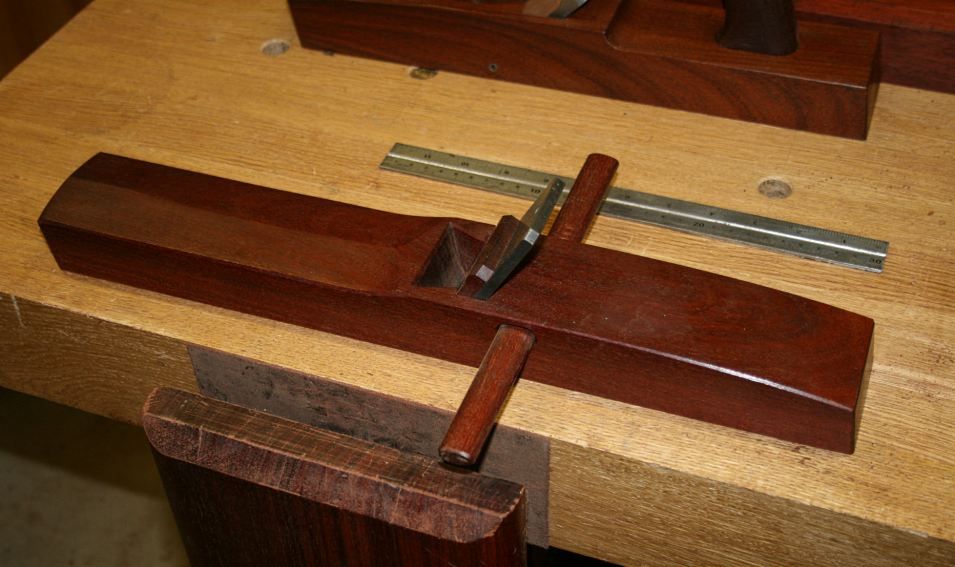
I love the way this plane performs, but I do not enjoy pushing it with the cross bar handle, and instead remove it, and wrap my hand around the body. This is quite uncomfortable as the body is square and the edges cut into the hand.
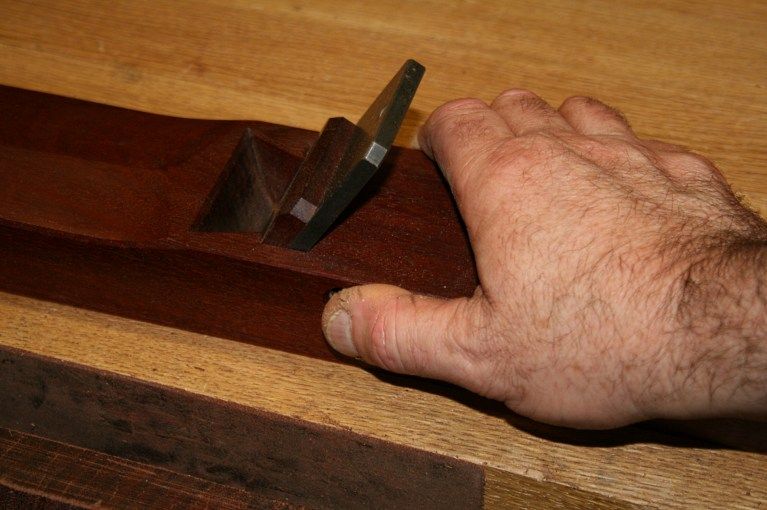
One may be excused for thinking that this plane is for pulling, as with a Japanese plane. The mouth is far back, compared to a Western plane. It is about half way. And there in lies the issues I faced - is there room for a handle, and how will this affect the balance?
For illustration, here is my 28" jointer and 15" jack plane alongside the trying plane ...

In the picture above I lined up the planes at the rear hand. Now look where the mouths are ...
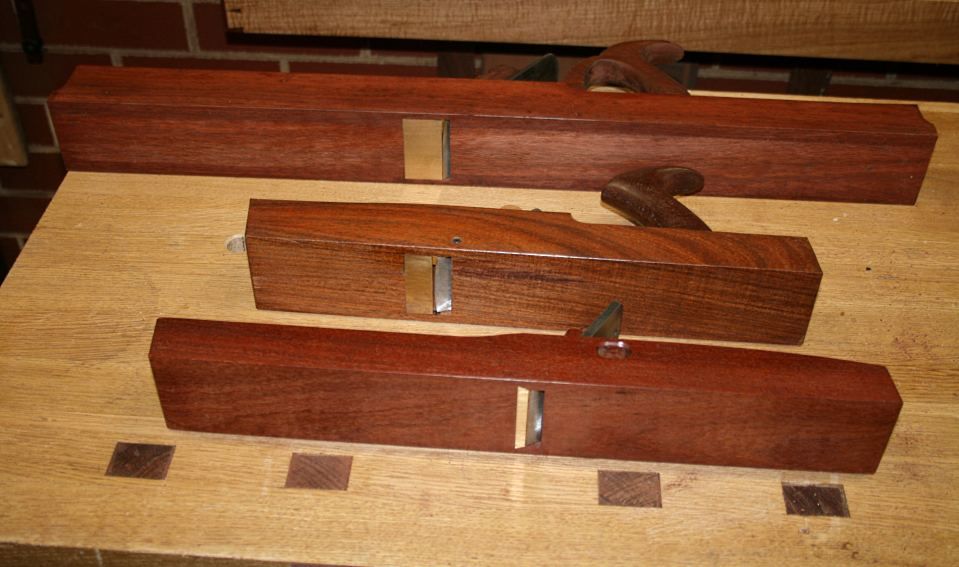
The HNT Gordon is definitely the odd one out - including a Stanley #7 reveals that the others are similar in placement of mouth and handle ...
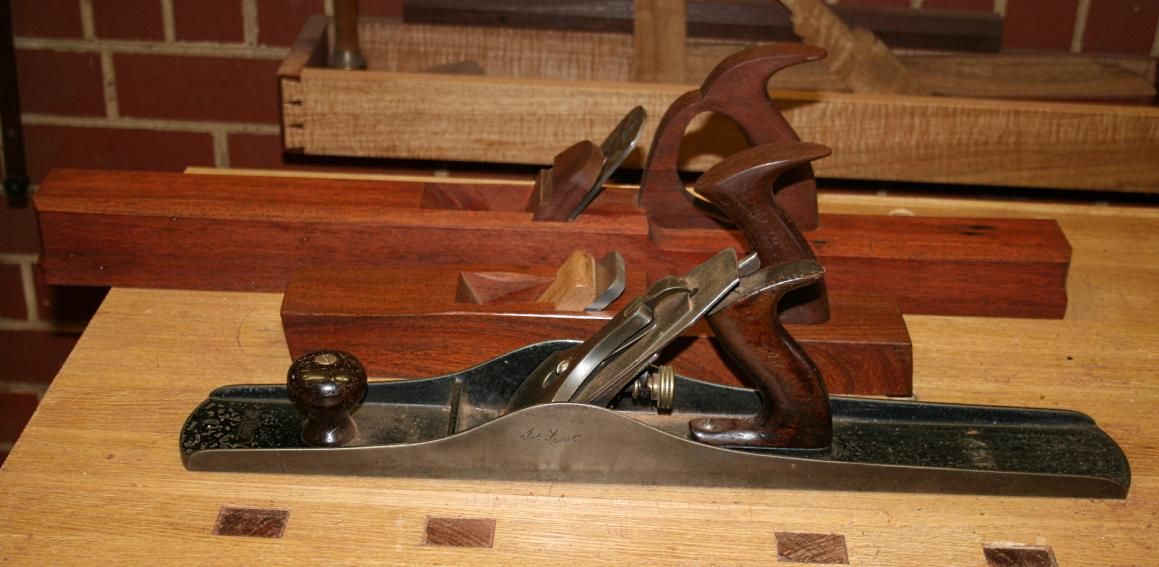
I did some research looking for information on the relationship of the handle to the mouth. I could find information on the mouth, but not where the handle should be placed. I do know, partly from experience, that the further back the handle, the less the control.
One other aspect that could change - probably would change - is the "feel". The reason I like the HNT Gordon planes in that they are low aspect with a low centre of effort. A handle would raise the centre of effort and change the nature of the plane.
The only reason I was prepared to go ahead was that the Trying Plane was stuttering into disuse as I now found it uncomfortable. And yet it worked so well.
So I built a handle. The white lines on the plane body indicate the position where my hand usually grips.
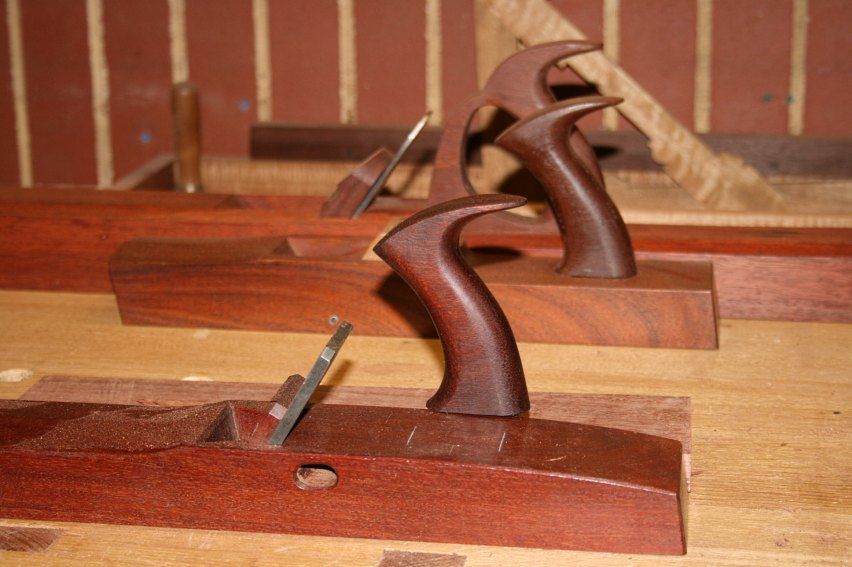
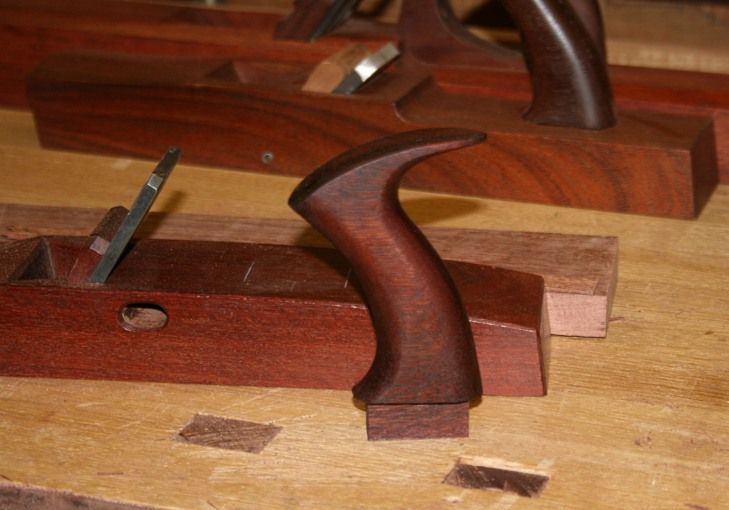
The body was morticed ...
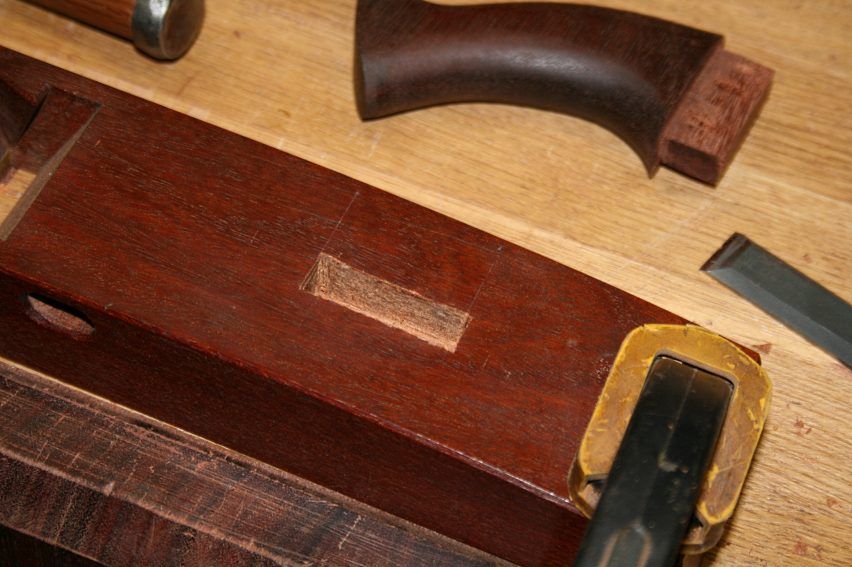
And the handle was epoxied in. I figure that epoxy is reversible with heat.
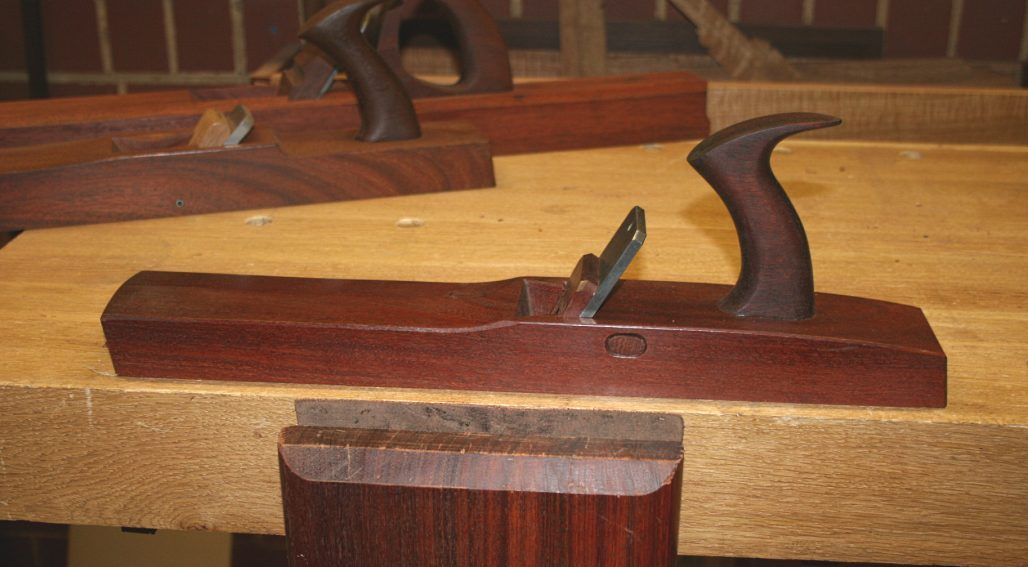
There is enough room to swing a plane hammer (this was not by luck! ) ...
) ...
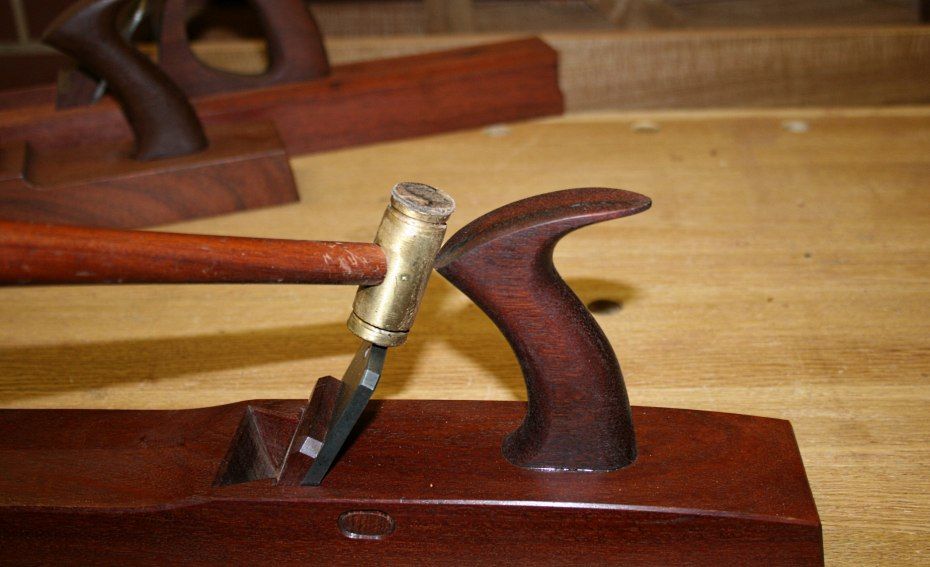
Trying out the new trying plane (ouch! Sorry!) ...
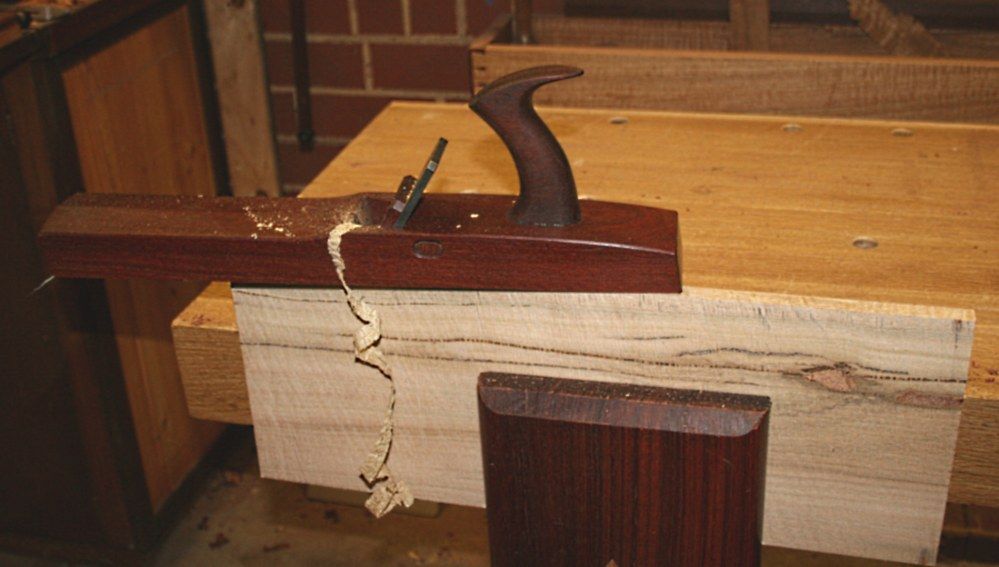 Visit www.inthewoodshop.com for tutorials on constructing handtools, handtool reviews, and my trials and tribulations with furniture builds.
Visit www.inthewoodshop.com for tutorials on constructing handtools, handtool reviews, and my trials and tribulations with furniture builds.
-
18th August 2013 02:16 AM # ADSGoogle Adsense Advertisement
- Join Date
- Always
- Location
- Advertising world
- Posts
- Many
-
18th August 2013, 02:17 AM #2

The handle is a good size, and fits my hand perfectly ...
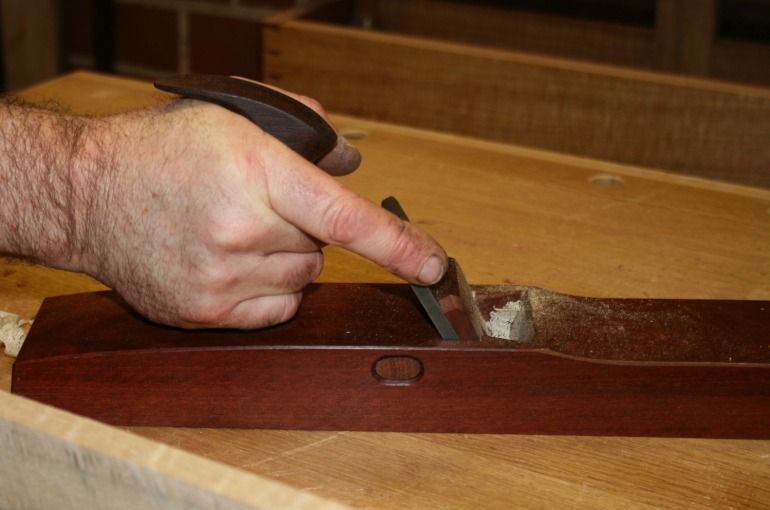
How does it feel? In a word, different. A little squirrely at first, then I became used to this and it was solid. But definitely different. The higher centre of effort is noticeable. The performance, however, has not changed - still fantastic.
I did find one other way to hold the plane, and that was to use the handle as a hook for the crook of my hand. This restored the low centre of effort.
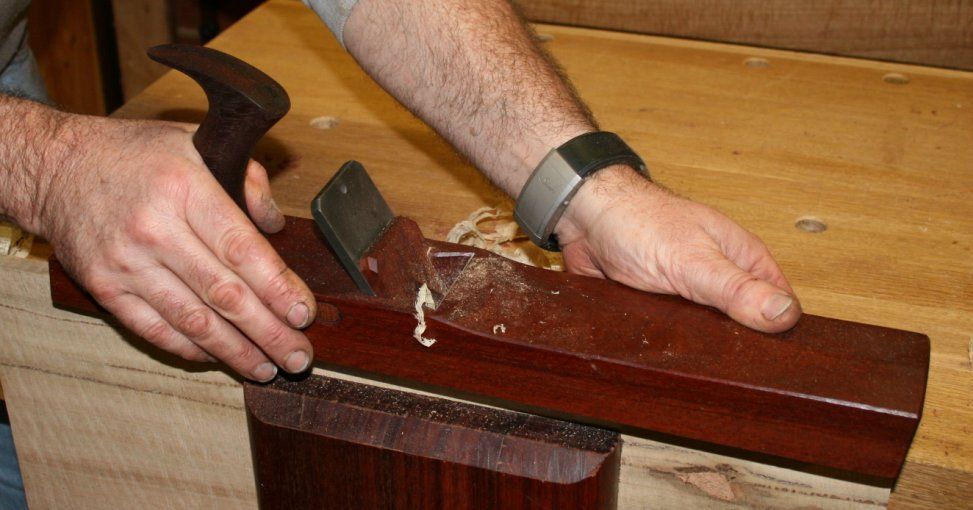
Any thoughts?
Regards from Perth
DerekVisit www.inthewoodshop.com for tutorials on constructing handtools, handtool reviews, and my trials and tribulations with furniture builds.
-
18th August 2013, 12:19 PM #3

I may wind up having this conversation with myself, if recent threads of mine continue their trend

The question is what is going on here (the plane handle, not my head! )
)
It becomes clearer to me that the placement of mouth and handle/hold is a compromise between the factors that promote stability (i.e. keeping the two as widely apart as possible) and maneuverability (i.e. bringing them closer). A higher centre of effort may make the mouth placement more critical (i.e. it needs to be further forward), while a lower centre of effort reduces this (i.e. the mouth can be moved back). The ideal is having the mouth further back as this increases registration - which, incidentally, is a feature on the LV bevel up planes.
I shall likely be replacing the handle for one similar to this one by Yeung Chan ...

Any thoughts on handle placement?
Regards from Perth
DerekVisit www.inthewoodshop.com for tutorials on constructing handtools, handtool reviews, and my trials and tribulations with furniture builds.
-
18th August 2013, 12:36 PM #4
 SENIOR MEMBER
SENIOR MEMBER











- Join Date
- Jan 2004
- Location
- Bellingen
- Posts
- 587

Hey I really like this! I have 4 HNT planes as well as a one I made. I was never a huge fan but still enjoyed the traditional Asian grip. I might have a look at trying out you handle mod idea some day.
I was about to comment and say what about a ball knob on the front of the Yeung Chan plane but relalised the black back was a thumb grip.
They Yeung grip looks nice and worthy of a go!
Thanks for posting this!
-
18th August 2013, 05:28 PM #5

Derek - The only handle-less planes I have are these two small smoothers that I made a couple of years ago:
Brass & ironwood smoother.jpg ironwood smoother.jpg
I tend to use them for small jobs & for short periods, & for that reason at least, comfort isn't a big issue. They are also narrow, which makes for a more comfortable handful than a wide body does.
Things don't always work out the way one plans, though. I put some effort into shaping the back of the little 'infill', giving it a nicely rounded top, which I swept up behind the blade to give the web of my hand something to butt against. It was meant to be the small smoother I'd go to for those little jobs that need some finesse, & it felt just the ticket when I finished it (but took some mucking about with to get working well, as related elsewhere). The little coffin smoother is just a bare-bones thing made to experiment with a blade-angle in-between its brassy mate and my 'full size' high-angle smoother. The back behind the blade was just rounded over with a rasp & paper - about 30 seconds expended on it. So it was a surprise to me when I noticed I always pick up the little woodie in preference to the other one! It has a slightly higher back, as you can see, but it seems to be just the right height for comfort for my hands (pure serendipity), and is so easy to control. The moral is, I can theorise, and do things as rationally as possible, but chance, or aspects I don't understand, often have a greater effect than my planning!
I suspect I like these little planes simply because they are small and fit in the hand so easily. I don't get on with the old wooden jacks & foreplanes at all. I find the handle-less ones far too bulky to hold comfortably, and that twisted-round left-hand grip you often see in old illustrations of blokes planing with larger woodies, looks like a recipe for RSI, to me (& feels like it, too!). But putting a handle on the back makes them worse, imo, by putting the centre of effort up far too high for me. Of course it doesn't help that my bench height is optimised for steel planes, since that was all I used for a very long time. The extra 50mm of height of the handle on a larger woodie is a very significant amount, when it comes to a longish planning session. It also gives the plane a squirrelly feel, as you mentioned. The Gordon & your whopper jointer both have quite a low back, which would bring the line of effort to somewhere in between that and a metal plane's.
As to placement of the handle, I like a rear tote to be a little behind the centre of gravity, if possible. If I can pick up a plane one handed and it's not far off-balance, like my all-time favourite 5 & 5 1/2 pair, that feels just right. Not only does that make it easy to aim & push, when you draw back after each stroke, the slight lifting effect 'dis-engages' the cutting edge.
Lastly - I notice some variation in the apparent angle of the grips on your 3 planes - is that just chance, or an optical illusion, or are you trying to compensate for the extra height?
Cheers,IW
-
18th August 2013, 10:10 PM #6

Hi Ian
Taking the handle (tote ... are we using this term any longer, or is it an American term?) first, as you know, the hang angle has a big part to play, equally for planes and saws.
The jointer does have a more upright angle. It is a heavy plane and just needs to be pushed forward. The jack is quite light, it designed to take deep slices, so more down force is required. The handle has more forward lean.
I had a look at Terry's two trying planes, the unhandled one and the handled one ...


He has pushed the mouth forward on the handled trying plane, but it is still far back compared with typical Western planes. And it has an even lower centre of effort as it is built into a razee. That tends to support what I said earlier, that the lower centre of effort "forgives" a long toe. I suspect that my trying plane would be improved by creating a razee rear.
That said, I had a bit more practice with the plane today. It works if you push with the heel of your hand when holding the handle. Again, this is low centre of effort stuff.
I have a couple of planes that I built similar to yours in size (probably a little smaller). Both have a similar cutting angle (60 degrees). One is BD and the other is BU.


The BU is so much easier to push. Again, it cannot be just the hand placement - which is similar - but the centre of effort, which is low for the BU plane.
This is not meant to be a pitch for BU planes, but that C of E needs to be incorporarted into the design of planes, BU or BD.
Regards from Perth
DerekVisit www.inthewoodshop.com for tutorials on constructing handtools, handtool reviews, and my trials and tribulations with furniture builds.
-
19th August 2013, 12:22 AM #7

It's too late now to get a pic but I razeed (can I make that a verb?) my Ulmia jointer, taking the handle to below half way through the thickness of the plane and moved it forward about an inch. It was just a bit unwieldy in my hands as it was and I found a long session would give me a sore right (back hand) elbow.
The mod has made a big difference to the control. I did wonder looking at your first post, Derek, how high your bench must be because I think that top mounted handle looks like it made the problem I wanted to cure - put the handle up too high. Of course that is relative to me and how I would imagine using the plane. The low Yeung grip looks good but for some reason on a jointer I like the idea of a handle. I'm not sure if I'm making this up but, ignoring the flattening function of the plane, I feel like I can adjust for square more easily with my handled jointer compared to my handle-less jack.
Looks tops in any case.
Matt...I'll just make the other bits smaller.
-
19th August 2013, 01:06 AM #8

Hi Matt
Your Ulmia looked like this .... (yes?)

That does have a strong similarity in terms of proportions of mouth and toe (but not height). The height on your plane allows for more to remove than the HNT Gordon. I am not sure whether than means that much. As I noted earlier, the handled Gordon's mouth is further forward, so I am uncertain whether a razee will work here. One factor that does argue in its favour is that the new handle wants to be held at the lower end, suggesting that is where its centre of effort lies.
Regards from Perth
DerekVisit www.inthewoodshop.com for tutorials on constructing handtools, handtool reviews, and my trials and tribulations with furniture builds.
-
19th August 2013, 09:28 AM #9

Derek - that's exactly what I was about to suggest, then saw you had got there first. Maybe combine with a knob on the front of the plane? Best position for a knob might be well back from the front of the plane, perhaps only a few inches ahead of the blade?
The other option, to get your hands even lower, is to have a rounded (and raised) back a la Krenov style planes. To avoid stuffing the body of the plane, you could make this from a block that sits on the back, and even try it attached with D/S tape before committing ! I'd make the rear curve steeper than on a (small) Krenov plane, as you need to be able to push more, and the sides would be fully rounded off. Shape to fit the crook of your hand. Doodle attached.
-
19th August 2013, 11:33 AM #10

A good suggestion, Mr. B. It gets the pushing hand down as low as possible. May be a bit awkward on longer planes, however, as you could end up working a long way from where the action is. I prefer to have my pushing hand close to the cutter, if possible, because it helps transmit some feel for what's going on (& I think Derek also mentioned this, above) where the rubber is hitting the road, so to speak.
I also take on board what Derek said about smaller planes needing a little more downward pressure to keep them cutting cf. a large & heavy brute. I think that is something I noticed very much with my small smoothers. The downward pressure on any plane can be assisted by the angle of the grip/tote/handle (I'm multi-lingual, I just use whichever term pops into my head first ), but to me, the more important reason for getting a particular angle is so that it puts my wrist in as straight a position as possible during the first 3rd to half of the stroke. As Matt found, it's not just the tendency to wobble that makes a 'high' tote/handle/grip awkward, it's the wrist position it dictates. If I have to have my wrist twisted up or down even a bit during that part of the planing stroke where I'm putting most effort into it, it's ok for a short while, but in a long session, the discomfort will soon become very noticeable.
), but to me, the more important reason for getting a particular angle is so that it puts my wrist in as straight a position as possible during the first 3rd to half of the stroke. As Matt found, it's not just the tendency to wobble that makes a 'high' tote/handle/grip awkward, it's the wrist position it dictates. If I have to have my wrist twisted up or down even a bit during that part of the planing stroke where I'm putting most effort into it, it's ok for a short while, but in a long session, the discomfort will soon become very noticeable.
The same considerations apply to hand saws, but there you usually have more scope to alter the angle at which you apply power - particularly with full-size saws being used over saw-horses, for e.g. Hang angle of the grip becomes more important on backsaws used for certain operations like dovetailing or sawing tenon shoulders, where the angle of the tooth line has to match the bottom of the cut, or at least for a good part of the sawing operation, while you cut down on your scribe marks. Having a grip angled so that you are mostly sawing with wrist in a 'neutral' position makes it much easier for me to control the saw, and also to hit the line on both sides simultaneously, without having to keep stopping & peering round the back of what I'm sawing, to check...
So yep, handle angles is a subject dear to my heart. You can hold onto just about anything for a short while, but well-placed, well thought-out handles makes a world of difference when you use a tool for a substantial part of a day. I got an early lesson in the effects of subtle changes in handles when hanging onto the end of a cane-knife for a few seasons. Minute differences can add up to something substantial, over a few thousand swings!
Cheers,IW
-
19th August 2013, 04:03 PM #11

I haven't read the replies yet, but I started thinking of the ECE smoother type of rear 'handle' ...

but that dark wood arrangement looks better.
Cheers,
Paul
-
19th August 2013, 04:17 PM #12

Yep that's the one and here's my pretty basic mod.
ImageUploadedByTapatalk1376889425.430512.jpg
Cheers
Matt...I'll just make the other bits smaller.
-
19th August 2013, 05:51 PM #13

Matt - I like the look of that.....still plenty of meat on the back of the plane. The shape reminds me of a corvette (ship) !
I should add that I don't own any large wooden planes. My #7 jointer is a metal jobbie.
I can appreciate that a handle (in any position) would give better control over the tilt of the plane than any of the modifications designed to be pushed with the sole of the hand.
Just out of interest, has anyone ever tried putting small corrugations in the sole of a long timber plane (as done with 7C Stanleys, etc) to reduce the friction, or is the timber sole slippery enough as it is?
-
19th August 2013, 08:17 PM #14

I think most people would go with the latter, Mr. B. One of the much-touted advantages of woodies is their inherent lower friction. It does depend a bit on the sole wood, and what wood it's planing, because some woods can be a bit sticky. But in general, wooden soles are a good deal more slippery than metal ones.
As a rough indication of the difference between a metal and a wooden sole, I show people what a difference it makes when I rub a bit of paraffin wax on the sole of a metal plane. It's quite dramatic, of course, but a woodie of about the same dimensions slides a bit better still (on average). So I don't think I will be routing grooves in any wooden planes soon.
I ought to confess that I'm not a fan of corrugated soles, anyway. I seriously doubt they convey any huge advantage over a swipe of paraffin wax. (Based on a sample size of 1, I hasten to add)....
Cheers,IW
-
19th August 2013, 08:23 PM #15

Mr B, the sole is plenty slick enough I think but in any case corrugating a wooden sole would not be advisable. One of the nice things about the wooden sole is that it is slick but it does wear gradually. That's not a problem because they're easy to flatten. If you had to re-groove the sole though... sheesh, I'd get a Stanley #7
 ...I'll just make the other bits smaller.
...I'll just make the other bits smaller.
Similar Threads
-
seeking panel raising plane and 'complex profile' plane templates
By Clinton1 in forum HAND TOOLS - UNPOWEREDReplies: 4Last Post: 13th January 2012, 06:21 AM -
Bandsaw Refit
By Stubchain in forum BANDSAWSReplies: 11Last Post: 16th July 2010, 07:59 PM -
Mando refit
By Sebastiaan56 in forum MUSICAL INSTRUMENTSReplies: 5Last Post: 3rd September 2007, 05:24 PM



 Likes:
Likes: 
 Reply With Quote
Reply With Quote

